Modeling of Electromagnetic Fields of the Traction Network Taking into Account the Influence of Metal Structures
Abstract
1. Introduction
2. Modeling Technique
- The current-carrying parts are represented in the form of straight segments, which are located in space according to the design of the object; some components, in particular, cables and parts of grounding systems, may be buried. To use the equations of a quasi-stationary zone, the size of the set of objects should not exceed several hundred meters.
- The analyzed network may include power lines and traction networks, transformers, loads, and sets of short conductors, which are modeled in the same way as power transmission line wires for calculation of operating parameters. The resistances of the wires are small; hence, this approach does not distort the network operating parameters. In addition, short-length grounded conductors can be used, specifically to model supports of power transmission lines and traction networks, substation portals, lightning rods, and others.
- The potentials and currents of short wires are determined by calculating the operating parameters in phase coordinates [32].
- The electric field is determined by the method of equivalent charges; the Bio-Savart formulas are used to calculate the magnetic field induction.
- Plain X0Z of the Cartesian coordinate system corresponds to the surface of the earth, the X axis is perpendicular to the railway route, and the Y axis is directed vertically upward.
3. Model Description
4. Modeling Results
- The presence of rolling stock in the form of metal wagons and tanks under the overpass, which can have a noticeable effect on the distribution of electromagnetic field strengths in the space surrounding the overpass;
- Pipelines, reinforced concrete platforms, and metal fences, which also affect the nature of the distribution of EMF.
5. Conclusions
- Current-carrying parts are represented as rectilinear segments that are located in space in accordance with the structure of the object; some elements, in particular grounding devices, can be located underground. To use the quasi-stationary zone equations, the dimensions of the set of objects should not exceed several hundred meters.
- The analyzed network can include power transmission lines and traction networks, transformers, loads, sets of short conductors, which are modeled in the same way as power transmission line wires for calculating the mode; due to the smallness of their resistance, this approach does not distort the network mode.
- The potentials and currents of short wires are determined by calculating the mode in phase coordinates.
- Systematicity—consisting in the possibility of modeling electromagnetic fields taking into account the properties and characteristics of a complex STE and the power supply electric power system;
- Universality—ensuring the modeling of power transmission lines and traction networks of various designs;
- Adequacy to the external environment—achieved by taking into account the profile of the underlying surface, underground communications, metal structures, artificial structures of railway transport, such as galleries, bridges, and tunnels;
- Complexity—ensured by combining the calculations of the mode and the determination of EMF strengths.
Author Contributions
Funding
Institutional Review Board Statement
Informed Consent Statement
Data Availability Statement
Conflicts of Interest
References
- Kosarev, A.B.; Kosarev, B.I. Fundamentals of Electromagnetic Safety for Power Supply Systems of Railway Transport; Intext: Moscow, Russia, 2008; 480p. [Google Scholar]
- Suslov, K.; Kryukov, A.; Voronina, E.; Fesak, I. Modeling Power Flows and Electromagnetic Fields Induced by Compact Overhead Lines Feeding Traction Substations of Mainline Railroads. Appl. Sci. 2023, 13, 4249. [Google Scholar] [CrossRef]
- Oancea, C.D.; Calin, F.; Golea, V. On the Electromagnetic Field in the Surrounding Area of Railway Equipment and Installations. In Proceedings of the 2019 International Conference on Electromechanical and Energy Systems (SIELMEN), Craiova, Romania, 9–11 October 2019; pp. 1–5. [Google Scholar] [CrossRef]
- Zhang, L.; Zhu, Y.; Chen, S.; Zhang, D. Simulation and Analysis for Electromagnetic Environment of Traction Network. In Proceedings of the 2021 XXXIVth General Assembly and Scientific Symposium of the International Union of Radio Science (URSI GASS), Rome, Italy, 28 August–4 September 2021; pp. 1–4. [Google Scholar] [CrossRef]
- Lu, N.; Zhu, F.; Yang, C.; Yang, Y.; Lu, H.; Wang, Z. The Research on Electromagnetic Emission of Traction Network With Short-Circuit Current Puls. IEEE Trans. Transp. Electrif. 2022, 8, 2029–2036. [Google Scholar] [CrossRef]
- Zalesova, O.V. Estimation of Induced Voltage on the Dead Overhead Power Line caused by Electromagnetic Influence of the 25 kV AC Electric Railway System. In Proceedings of the 2019 International Multi-Conference on Industrial Engineering and Modern Technologies (FarEastCon), Vladivostok, Russia, 1–4 October 2019; pp. 1–4. [Google Scholar] [CrossRef]
- Serdiuk, T.; Serdiuk, K.; Profatylov, V.; Adhena, H.H.; Thomas, D.; Greedy, S. Analysis of Electrified Systems and Electromagnetic Interference on the Railways. IEEE Lett. Electromagn. Compat. Pract. Appl. 2023, 5, 3. [Google Scholar] [CrossRef]
- Serdiuk, T.; Feliziani, M.; Serdiuk, K. About Electromagnetic Compatibility of Track Circuits with the Traction Supply System of Railway. In Proceedings of the 2018 International Symposium on Electromagnetic Compatibility (EMC EUROPE), Amsterdam, The Netherlands, 27–30 August 2018. [Google Scholar]
- Apollonskii, S.M.; Gorsky, A.N. Calculation of electric and magnetic field strengths produced by a direct current traction network. In Proceedings of the IEEE EUROCON 2009, St. Petersburg, Russia, 18–23 May 2009. [Google Scholar]
- Apollonskii, S.M. Estimation of the electromagnetic environment on objects of the railway electrified on direct current. In Proceedings of the IEEE EUROCON 2009, St. Petersburg, Russia, 18–23 May 2009. [Google Scholar]
- Martins-Britto, A.G.; Moraes, C.M.; Lopes, F.V.; Rondineau, S. Low-frequency Electromagnetic Coupling Between a Traction Line and an Underground Pipeline in a Multilayered Soil. In Proceedings of the 2020 Workshop on Communication Networks and Power Systems (WCNPS), Brasilia, Brazil, 12–13 November 2020. [Google Scholar]
- Vieira, P.; Cota, N.; Rodrigues, A. A VLF to UHF propagation model for evaluation of high-speed railway electromagnetic emissions in outside world. In Proceedings of the 15th International Symposium on Wireless Personal Multimedia Communications, Taipei, Taiwan, 24–27 September 2012. [Google Scholar]
- Long, Y.; Li, Y.; Liang, Y.; Cheng, X.; Zhao, Y.; Cao, X. Research on electromagnetic pollution control methods in urban rail transit tunnels. In Proceedings of the 2022 IEEE International Conference on High Voltage Engineering and Applications (ICHVE), Chongqing, China, 25–29 September 2022. [Google Scholar]
- Bondarenko, I.; Neduzha, L. Development Genesis of Functional Safety on the Example of an Element of the Railways Infrastructure Subsystem. In Lecture Notes in Intelligent Transportation and Infrastructure; Springer: Cham, Switzerland, 2024; pp. 529–538. [Google Scholar]
- Yanhulova, O.; Keršys, R.; Neduzha, L. Security Risk Assessment at Transport Infrastructure Facilities. In Proceedings of the Transport Means—Proceedings of the International Conference, Palanga, Lithuania, 4–6 October 2023; pp. 574–578. [Google Scholar]
- Bondarenko, I.; Campisi, T.; Tesoriere, G.; Neduzha, L. Using Detailing Concept to Assess Railway Functional Safety. Sustainability 2023, 15, 18. [Google Scholar] [CrossRef]
- Bondarenko, I.O.; Neduzha, L.O. The problem of a lack of material behaviour data for risk assessment. Sci. Transp. Prog. 2021, 6, 43–56. [Google Scholar] [CrossRef]
- Bondarenko, I.; Severino, A.; Olayode, I.; Campisi, T.; Neduzha, L. Dynamic Sustainable Processes Simulation to Study Transport Object Efficiency. Infrastructures 2022, 7, 124. [Google Scholar] [CrossRef]
- Zhou, K.; Wang, X.; Lin, X.; Sun, H.; Liu, Z. Simulation of electromagnetic field distribution and coupling effect of overhead transmission line based on MEMS technology. In Proceedings of the 2021 International Conference on Information Control, Electrical Engineering and Rail Transit (ICEERT), Lanzhou, China, 30 October–1 November 2021. [Google Scholar]
- Delfino, F.; Procopio, R.; Rossi, M. A field-to-line coupling model for overvoltage analysis in light-rail transit DC traction power systems. IEEE Trans. Power Delivery 2005, 21, 270–277. [Google Scholar] [CrossRef]
- Schmautzer, E.; Propst, G.; Graz, K.F. The effect of reduction conductors on the magnetic field of electrified railway systems near hospitals. In Proceedings of the Electrical Systems for Aircraft, Railway and Ship Propulsion, Bologna, Italy, 19–21 October 2010. [Google Scholar]
- Qabazard, A.M. Survey of Electromagnetic Field Radiation Associated with Power Transmission Lines in the State of Kuwait. In Proceedings of the 2007 International Conference on Electromagnetics in Advanced Applications, Turin, Italy, 17–21 September 2007. [Google Scholar]
- Ren, M.; Yin, F.; Fang, Y.; Chen, J.; Qin, Z. Electromagnetic Studies of AC Transmission Lines and Off-Line Personnel. In Proceedings of the 2024 4th International Conference on Energy Engineering and Power Systems (EEPS), Hangzhou, China, 9–11 August 2024. [Google Scholar]
- Taheri, P.; Kordi, B.; Gole, A. Transient Electromagnetic Fields associated with a power transmission line above a lossy ground. In Proceedings of the 2009 13th International Symposium on Antenna Technology and Applied Electromagnetics and the Canadian Radio Science Meeting, Banff, AB, Canada, 15–18 February 2009. [Google Scholar]
- Chen, J.-H.; Chen, K.-L. A Study of Electromagnetic Field Model for Suspended Overhead Transmission Lines. In Proceedings of the 2023 13th International Conference on Power, Energy and Electrical Engineering (CPEEE), Tokyo, Japan, 25–27 February 2023. [Google Scholar]
- El-Refaie, E.-S.M.; Ahmed, A.-L.S.; Mohamed, S.M.; Gaber, H.M. Electromagnetic field interference between high voltage transmission lines and nearby metallic gas pipelines. In Proceedings of the 2017 Nineteenth International Middle East Power Systems Conference (MEPCON), Cairo, Egypt, 19–21 December 2017. [Google Scholar]
- Han, W.; Yang, B.; Wang, L.; Jing, Y.; Wang, Y.; Wu, J. Study on the influence of conductor arrangement on the electromagnetic environment of DC transmission line constructed with AC transmission line in the same transmission line corridor. In Proceedings of the 2020 IEEE International Conference on High Voltage Engineering and Application (ICHVE), Beijing, China, 6–10 September 2020. [Google Scholar]
- Wang, Y.; Wang, H.; Xue, H.; Yang, C.; Yan, T. Research on the electromagnetic environment of 110kV six-circuit transmission line on the same tower. In Proceedings of the IEEE PES Innovative Smart Grid Technologies, Tianjin, China, 21–24 May 2012. [Google Scholar]
- Geng, D.; Li, C.; Xu, G.; Zhao, Z.; Wang, Y.; Yan, W. Development of Electromagnetic Environment of Three Phase Power Lines for Bio-Effects Evaluation. In Proceedings of the 2012 Sixth International Conference on Electromagnetic Field Problems and Applications, Dalian, China, 19–21 June 2012. [Google Scholar]
- Tashi, Q.; Yue, S.; Duo, B.; Gao, L.; Tenzin, D.; Li, L.; Yang, F. The Measurement and Analysis of Electromagnetic Environment of DC Transmission Line in High Altitude Areas. In Proceedings of the 2021 3rd Asia Energy and Electrical Engineering Symposium (AEEES), Chengdu, China, 26–29 March 2021. [Google Scholar]
- Yang, C.; Zhu, F.; Yang, Y.; Lu, N.; Dong, X. Modeling of catenary electromagnetic emission with electrified train passing through neutral section. Int. J. Electr. Power Energy Syst. 2022, 147, 108899. [Google Scholar] [CrossRef]
- Yu, X.; Yang, J.; Su, Y.; Song, L.; Wei, C.; Cheng, Y.; Liu, Y. A Study on the Electromagnetic Environment and Experimental Simulation of Electrified Railroad Mobile Catenary Liu. Sustainability 2025, 17, 1518. [Google Scholar] [CrossRef]
- Zakaryukin, V.P.; Kryukov, A.V. Modeling of electromagnetic fields created by a system of short current-carrying parts. Syst. Anal. Math. Model. 2021, 3, 145–163. [Google Scholar]
- Zakaryukin, V.P.; Kryukov, A.V. Complex Unbalanced Conditions of Electrical Systems; Irkutsk University Publishing House: Irkutsk, Russia, 2005; 273p. [Google Scholar]
- Suslov, K.; Kryukov, A.; Voronina, E.; Ilyushin, P. Consideration of the influence of supports in modeling the electromagnetic fields of 25 kV traction networks under emergency conditions. Glob. Energy Interconnect. 2024, 7, 528–540. [Google Scholar] [CrossRef]
- Smirnov, A.S.; Solonina, N.N.; Suslov, K.V. Separate measurement of fundamental and high harmonic energy at consumer inlet—A way to enhancement of electricity use efficiency. In Proceedings of the 2010 International Conference on Power System Technology: Technological Innovations Making Power Grid Smarter, POWERCON2010, Zhejiang, China, 24–28 October 2010; p. 5666617. [Google Scholar]
- Bulatov, Y.N.; Cherepanov, A.V.; Kryukov, A.V.; Suslov, K. Distributed Generation in Railroad Power Supply Systems. In Proceedings of the 2020 3rd International Colloquium on Intelligent Grid Metrology, SMAGRIMET, Cavtat, Croatia, 20–23 October 2020. [Google Scholar] [CrossRef]
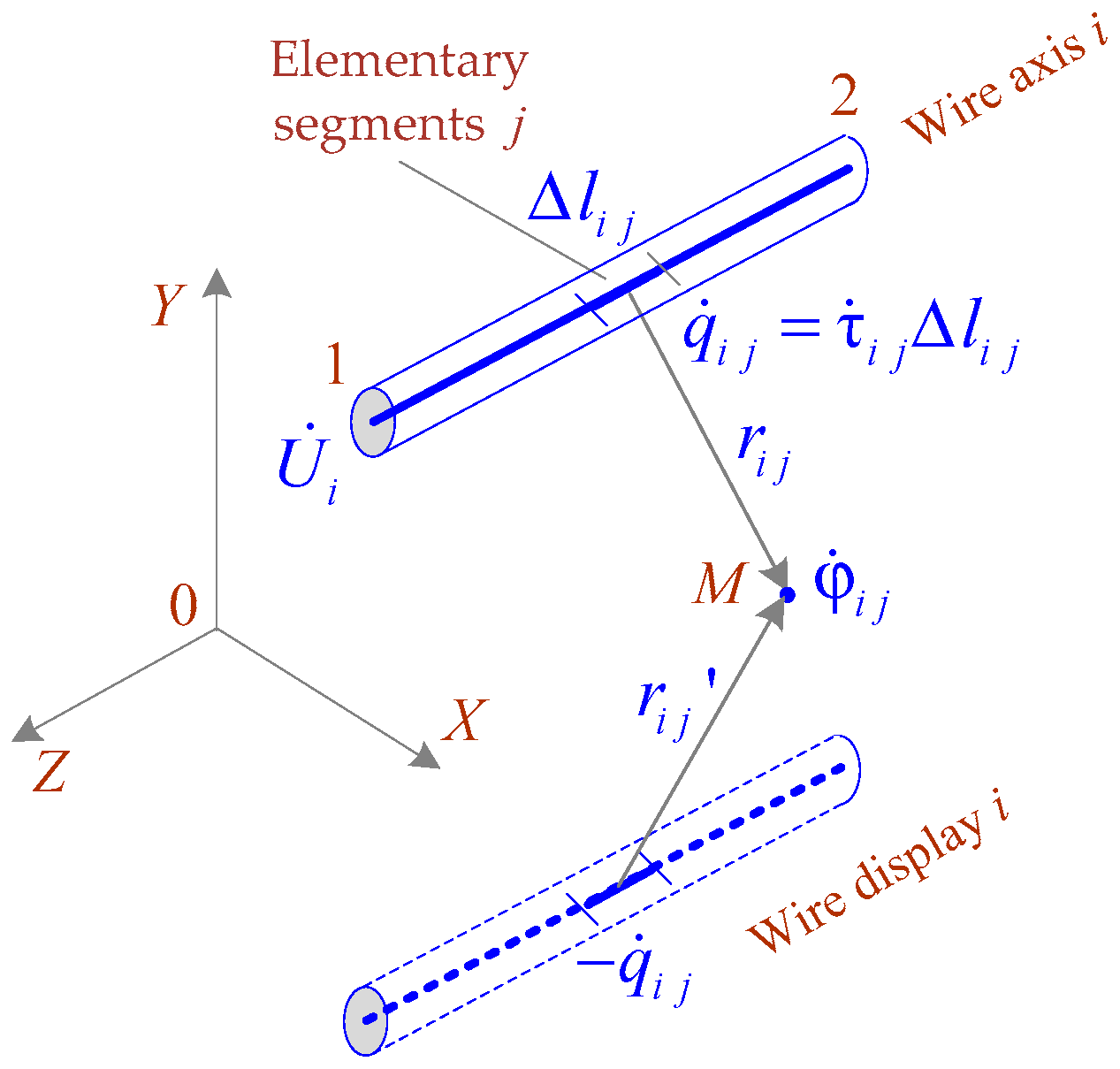
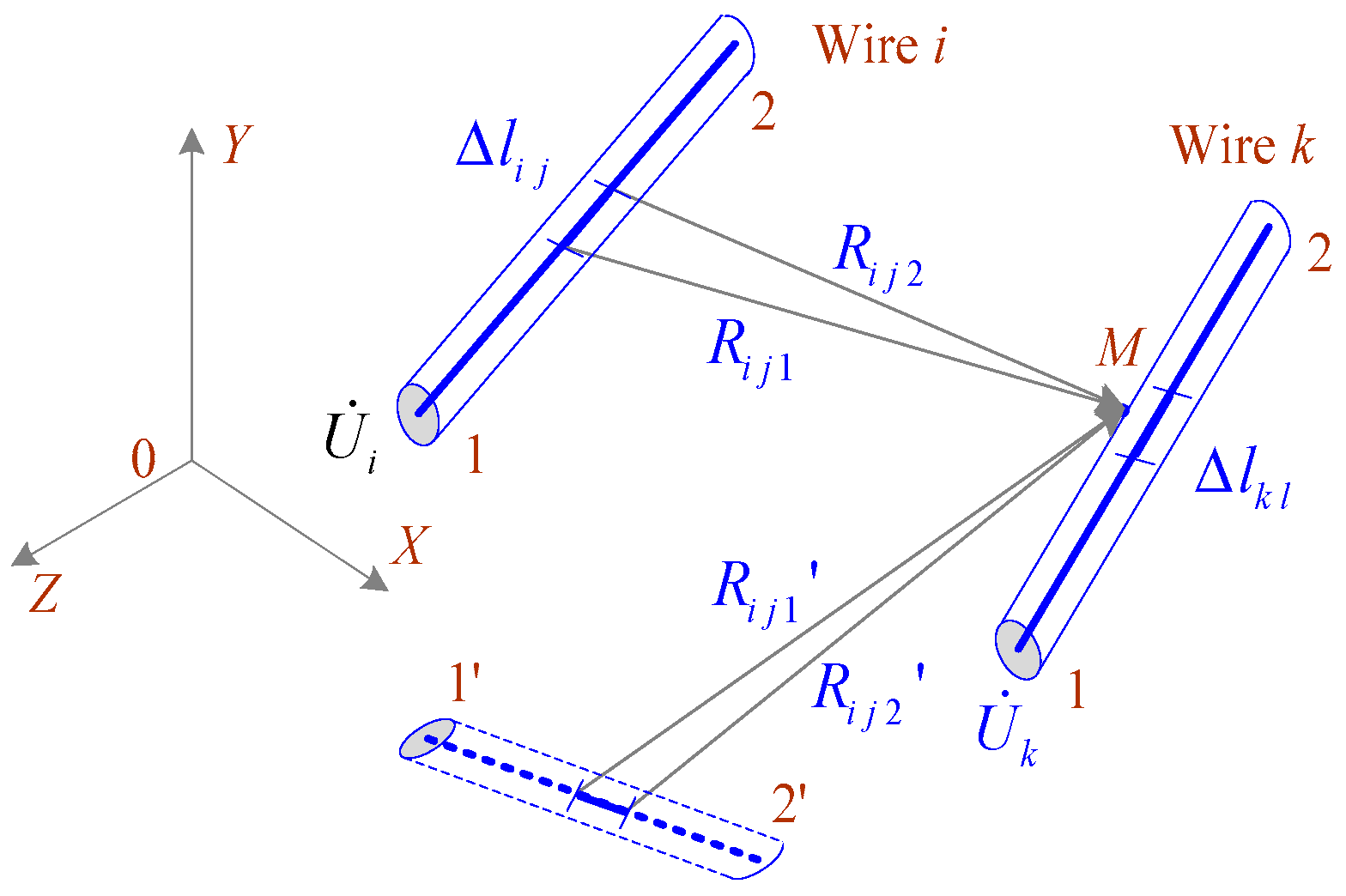
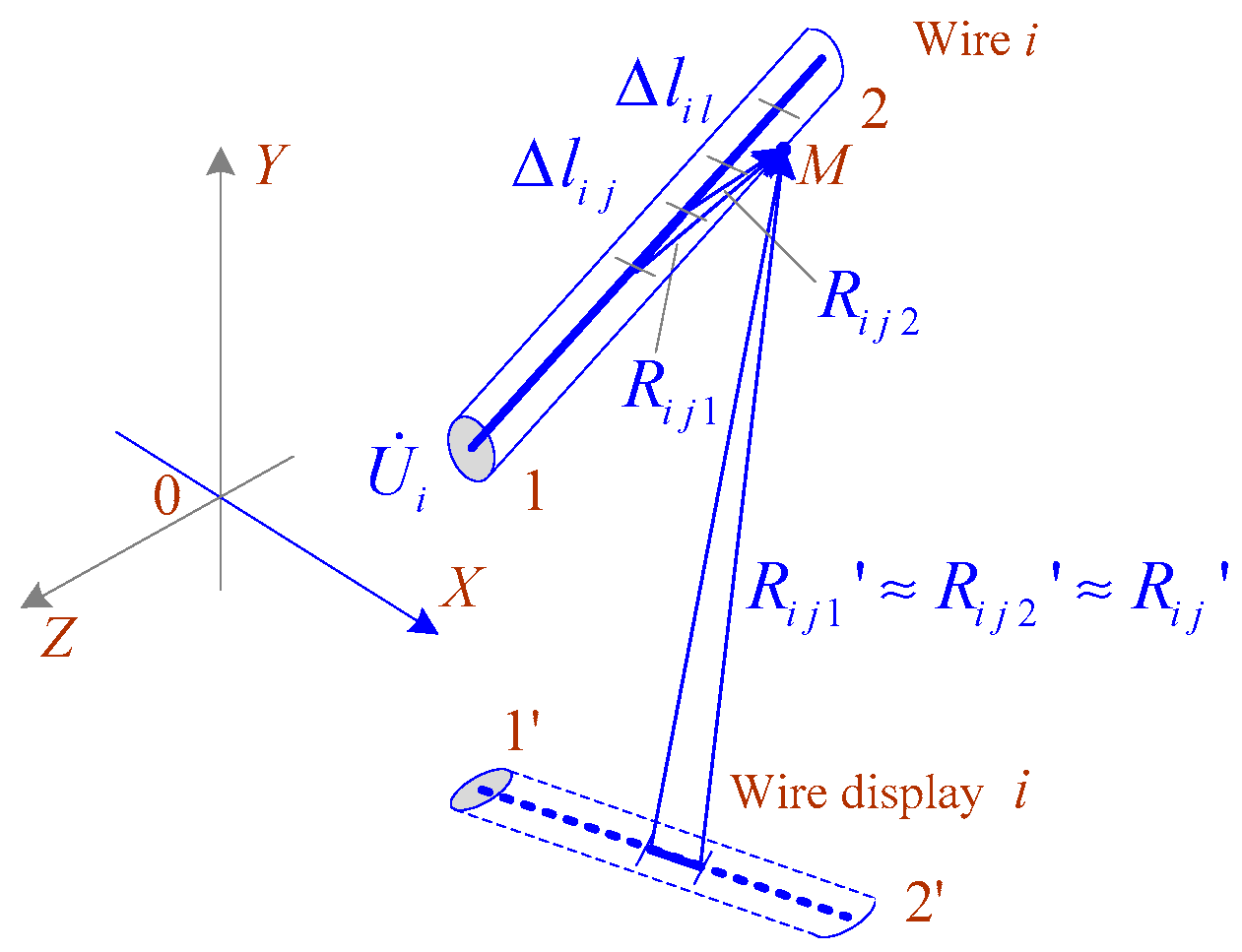
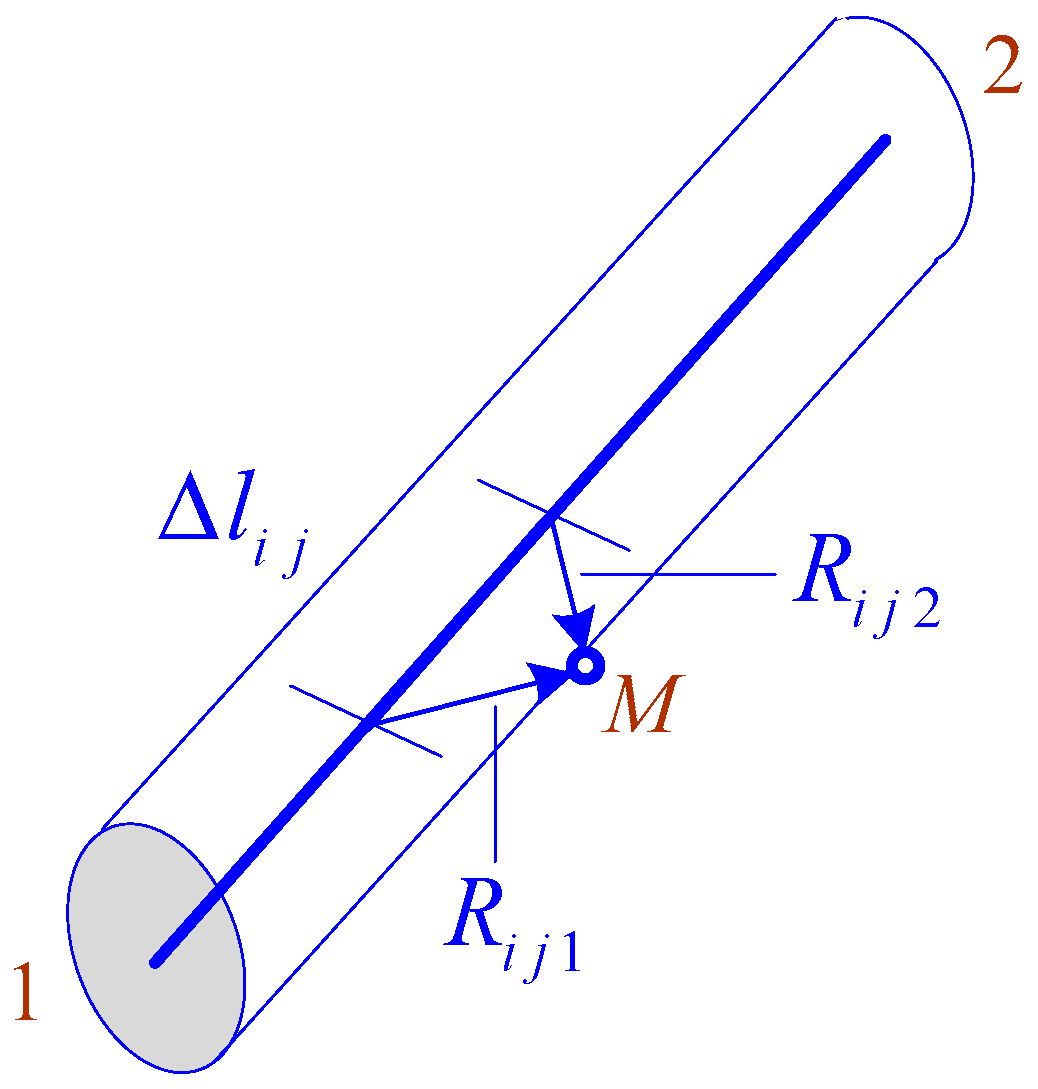
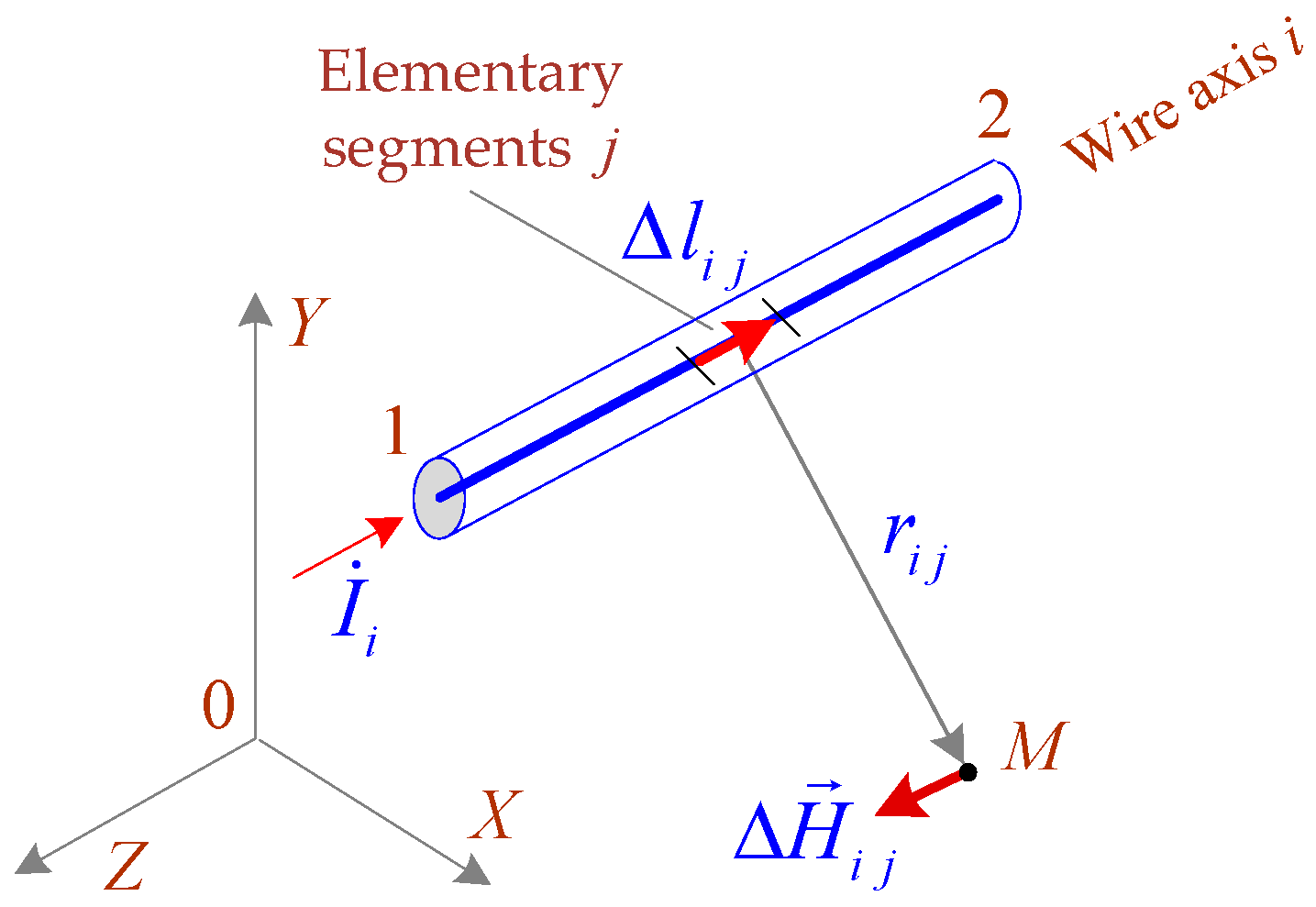
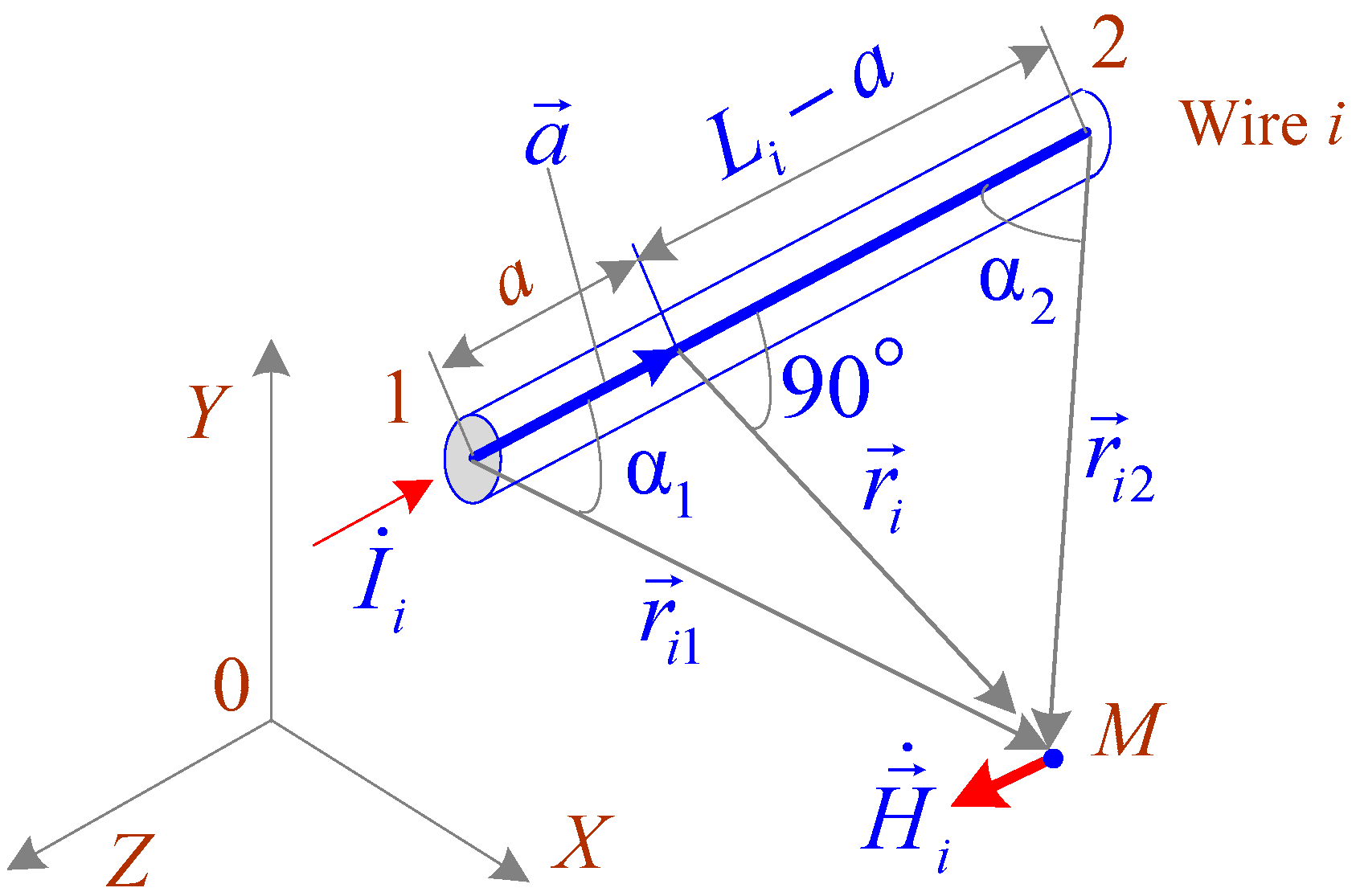
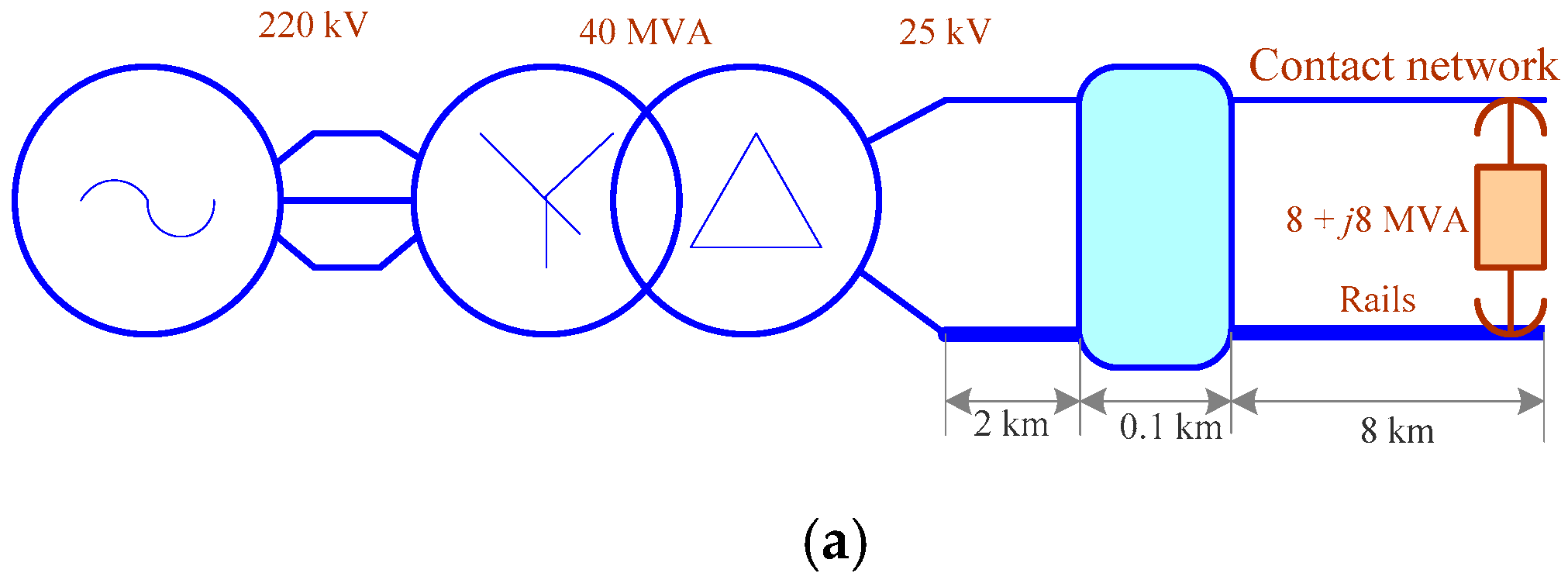
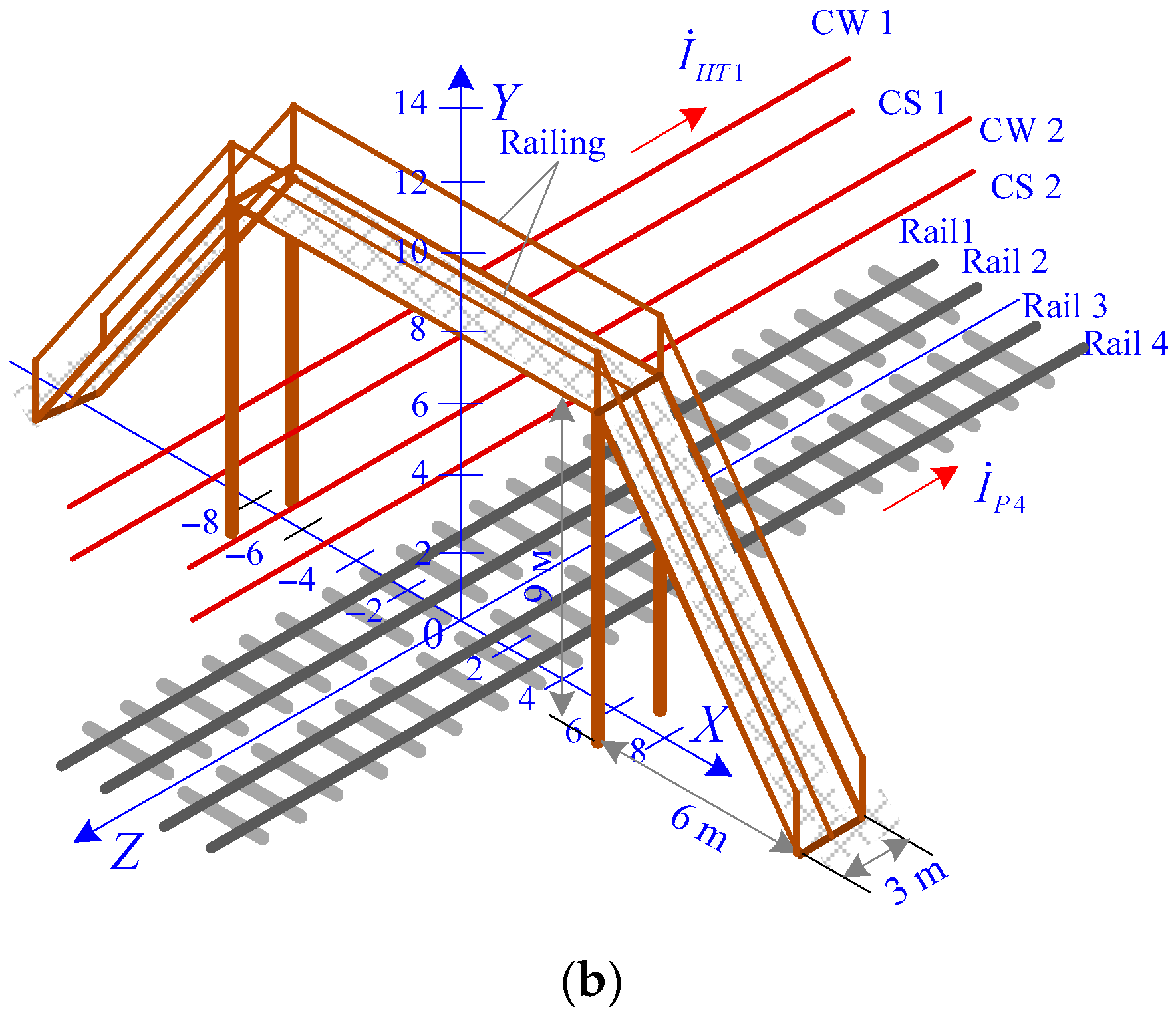

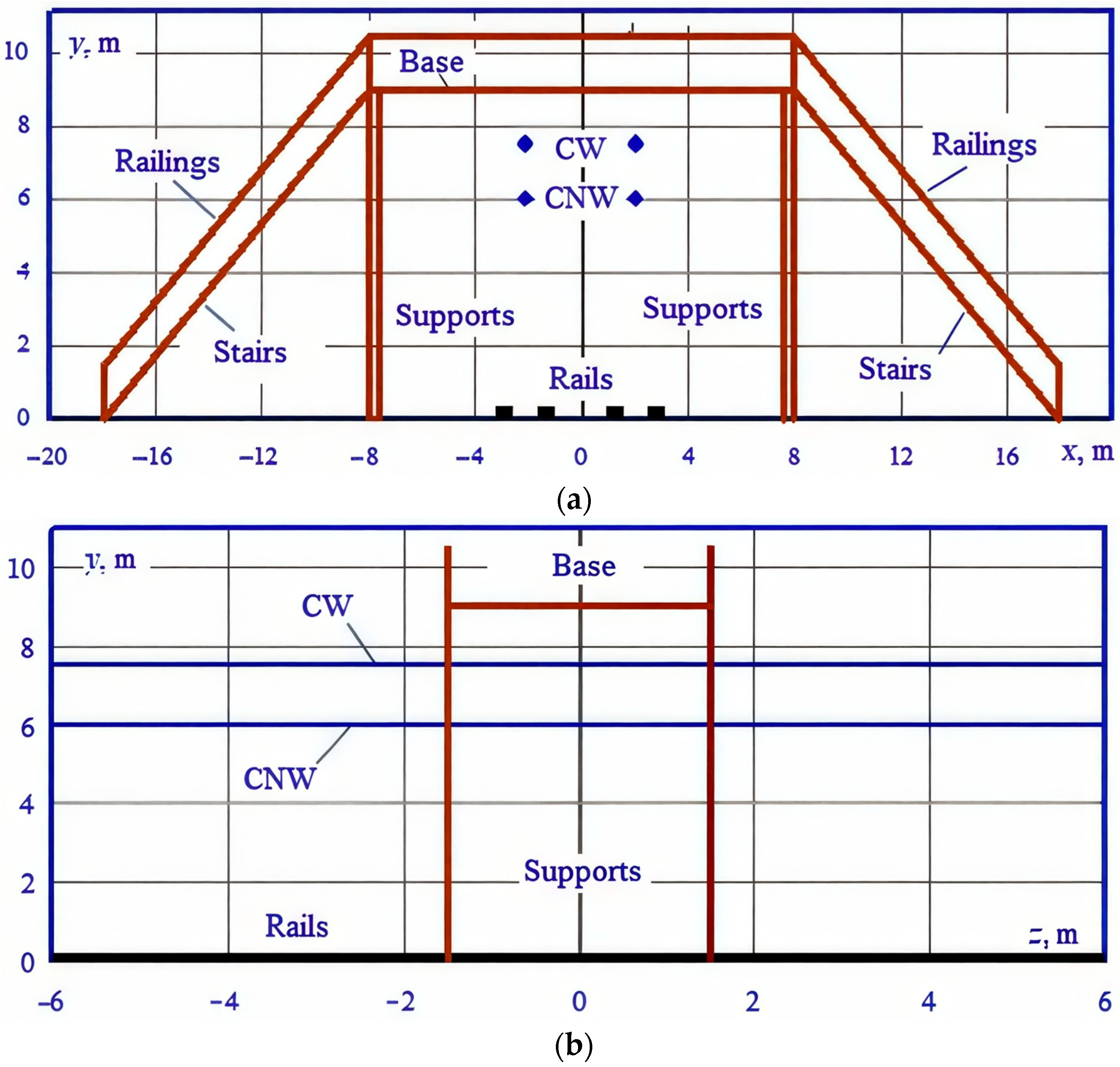
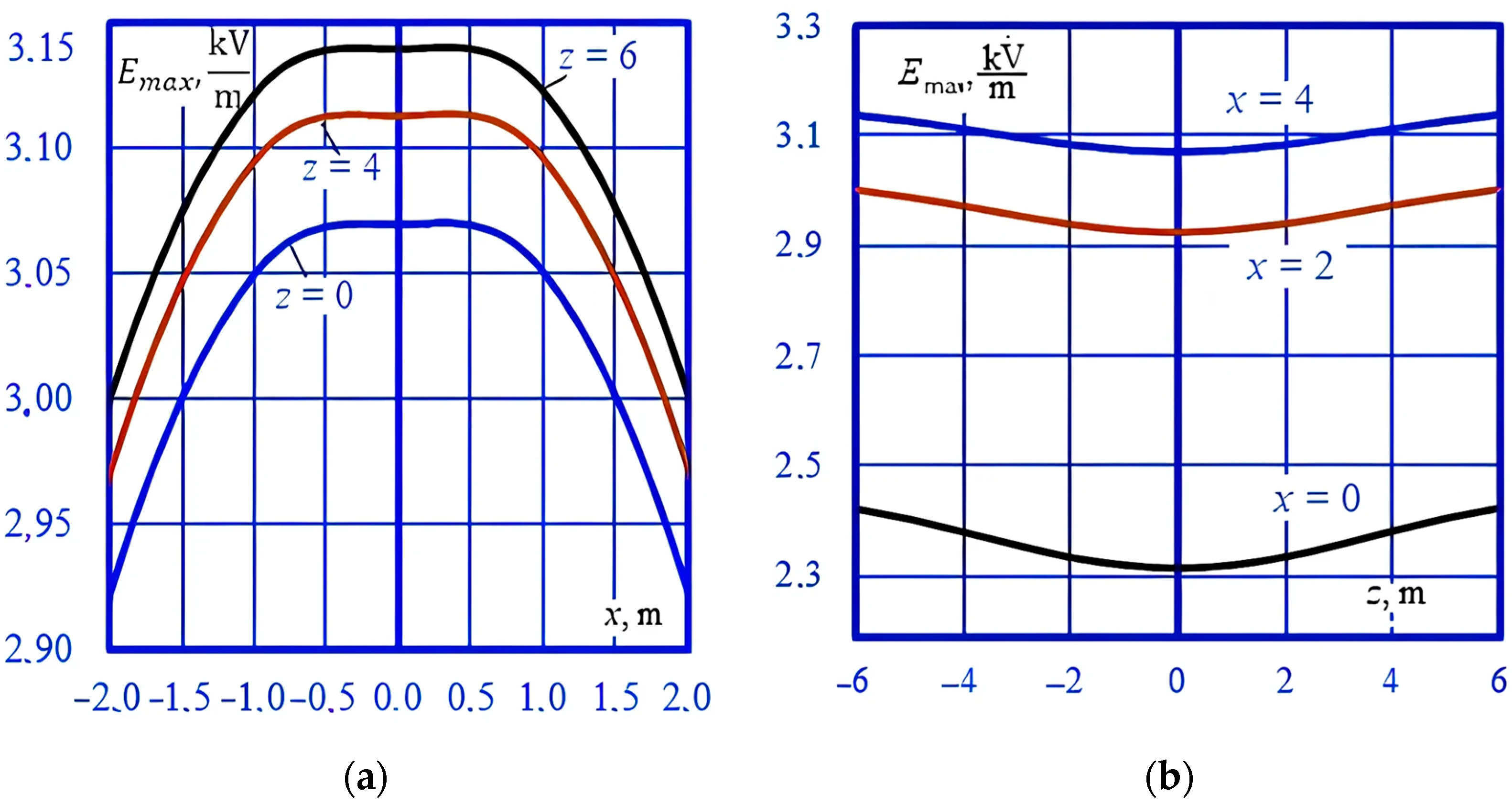


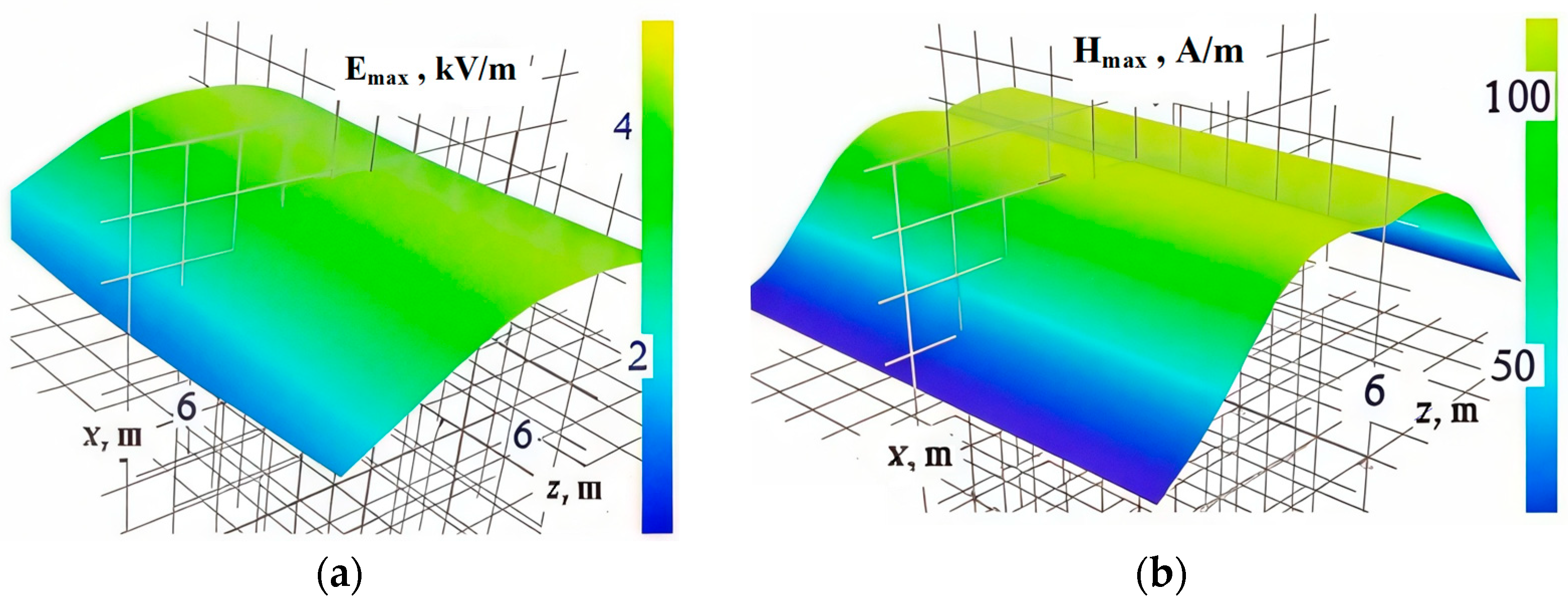

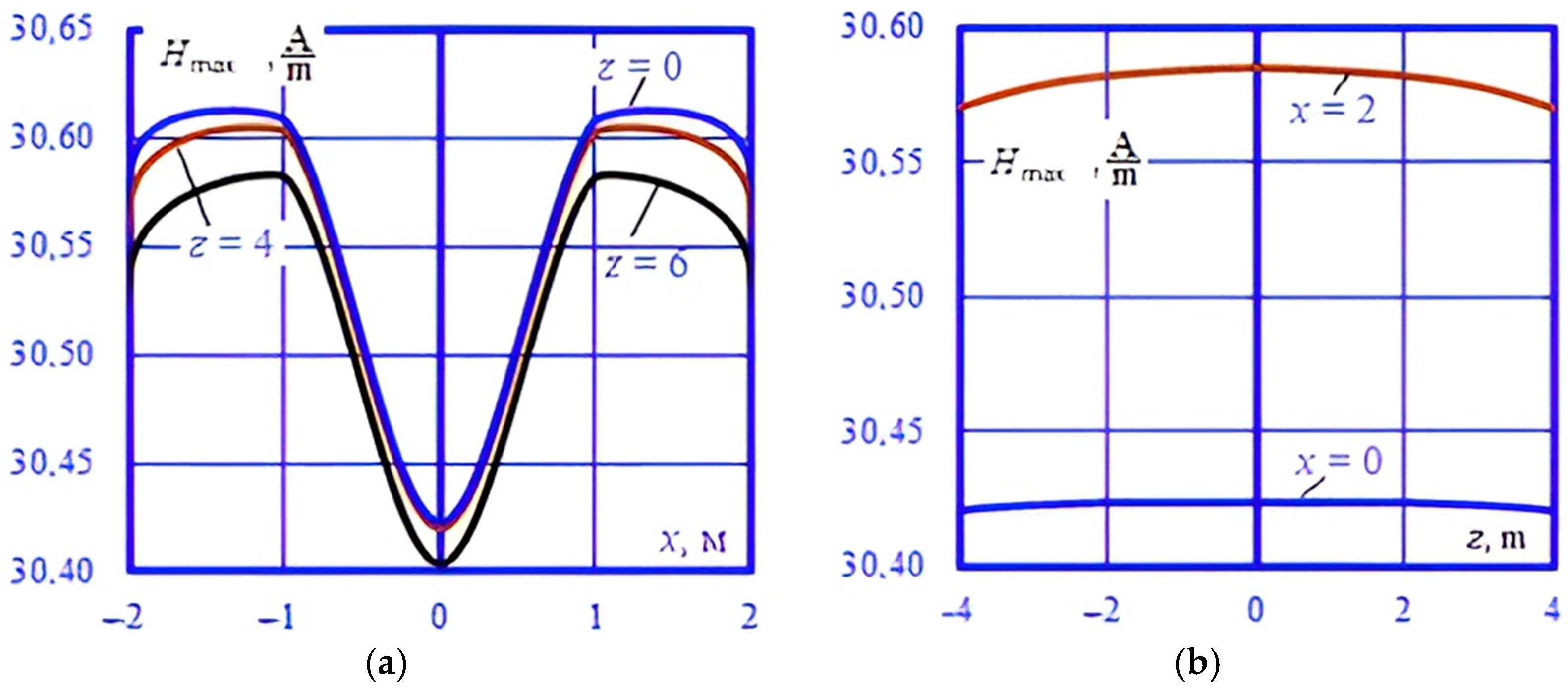
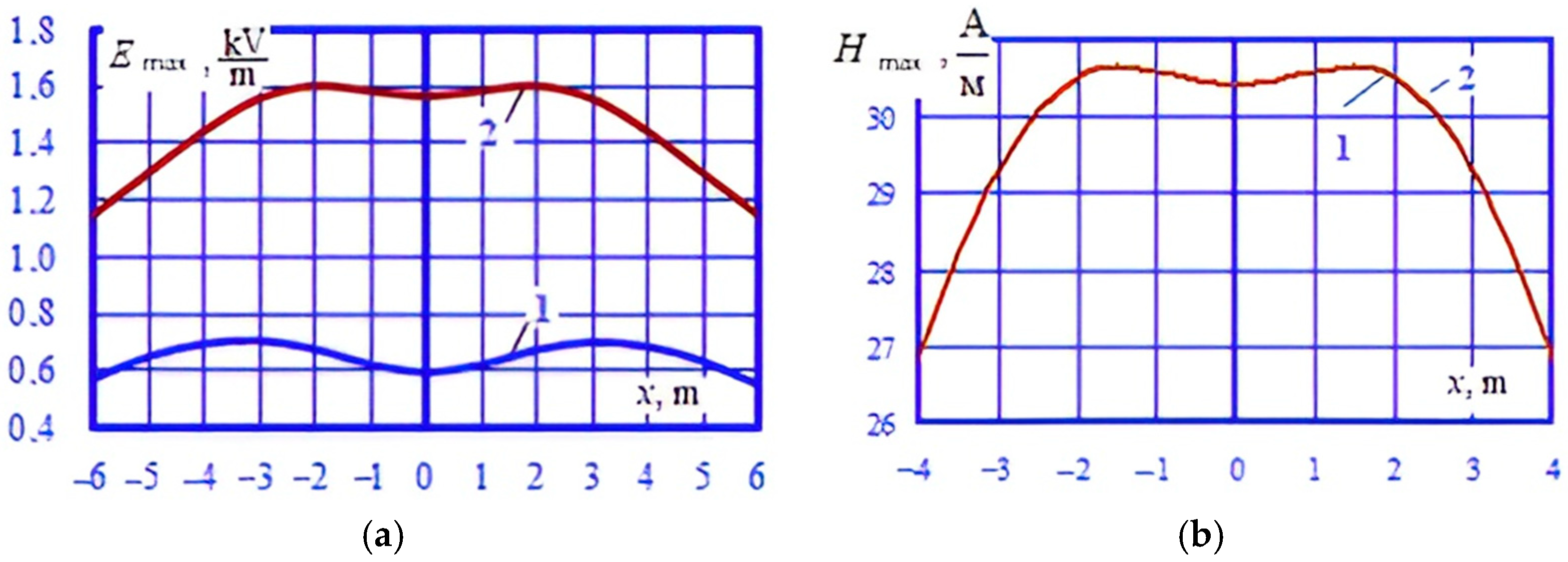
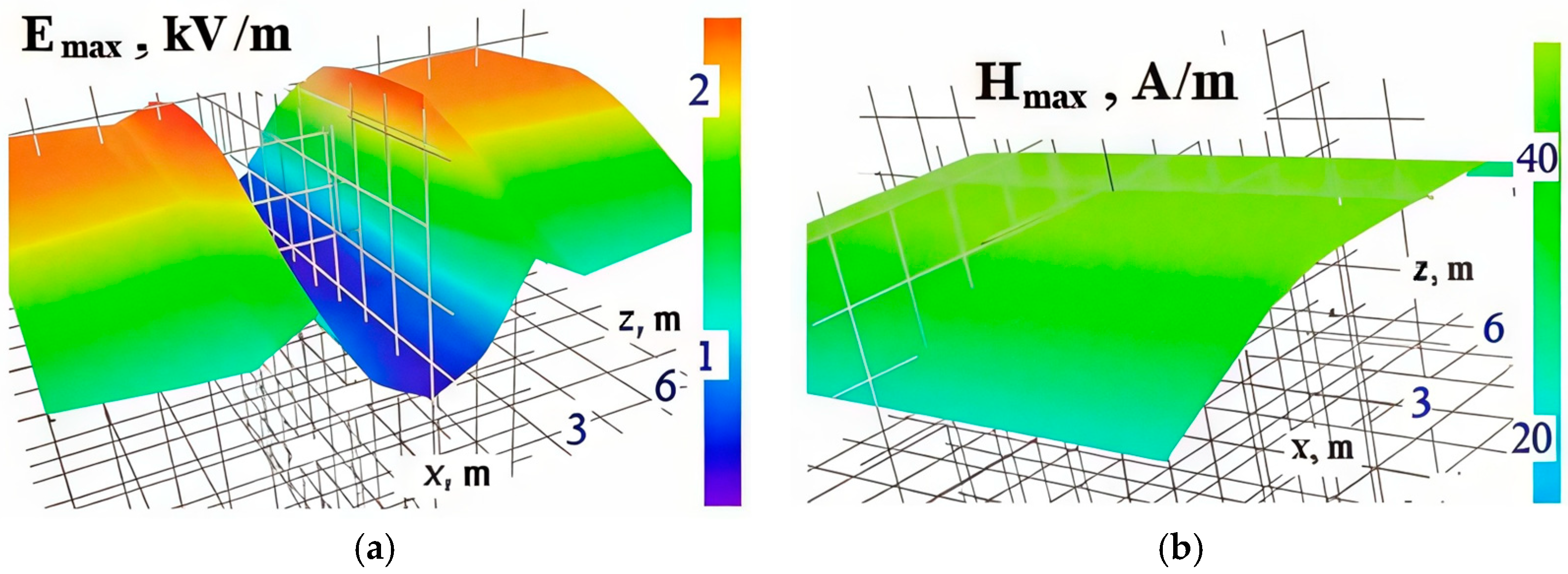
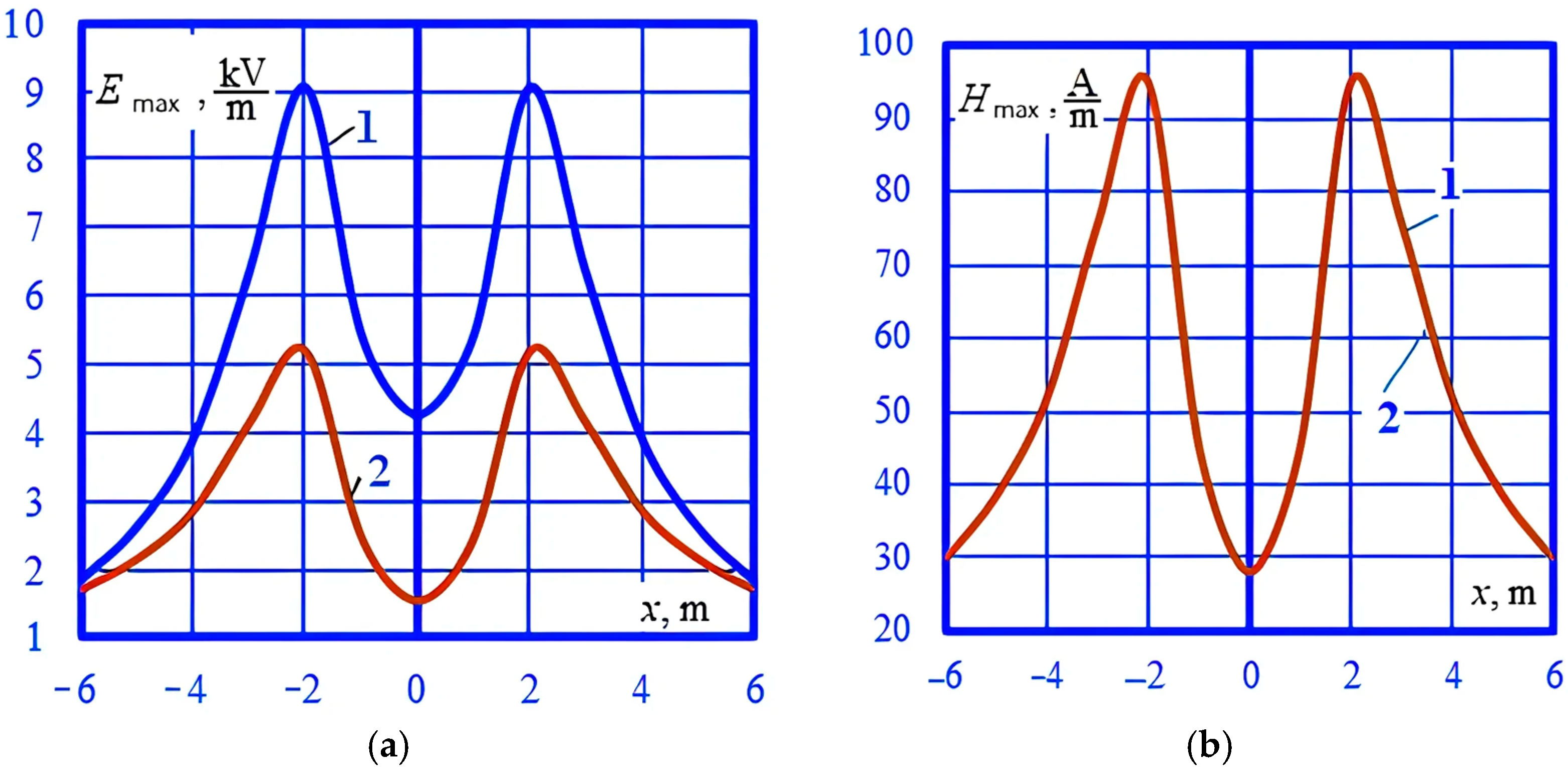
| Method | ||
|---|---|---|
| EMF of short wires | 3.20 0.04 | 77.67 0.9 |
| Plane-parallel EMF | 3.26 0.04 | 80.07 0.9 |
| Difference between the EMF of short wires and the plane-parallel field, % | −1.8 | −3.0 |
Disclaimer/Publisher’s Note: The statements, opinions and data contained in all publications are solely those of the individual author(s) and contributor(s) and not of MDPI and/or the editor(s). MDPI and/or the editor(s) disclaim responsibility for any injury to people or property resulting from any ideas, methods, instructions or products referred to in the content. |
© 2025 by the authors. Licensee MDPI, Basel, Switzerland. This article is an open access article distributed under the terms and conditions of the Creative Commons Attribution (CC BY) license (https://creativecommons.org/licenses/by/4.0/).
Share and Cite
Iliev, I.; Kryukov, A.; Suslov, K.; Voronina, E.; Batukhtin, A.; Beloev, I.; Valeeva, Y. Modeling of Electromagnetic Fields of the Traction Network Taking into Account the Influence of Metal Structures. Appl. Sci. 2025, 15, 6451. https://doi.org/10.3390/app15126451
Iliev I, Kryukov A, Suslov K, Voronina E, Batukhtin A, Beloev I, Valeeva Y. Modeling of Electromagnetic Fields of the Traction Network Taking into Account the Influence of Metal Structures. Applied Sciences. 2025; 15(12):6451. https://doi.org/10.3390/app15126451
Chicago/Turabian StyleIliev, Iliya, Andrey Kryukov, Konstantin Suslov, Ekaterina Voronina, Andrey Batukhtin, Ivan Beloev, and Yuliya Valeeva. 2025. "Modeling of Electromagnetic Fields of the Traction Network Taking into Account the Influence of Metal Structures" Applied Sciences 15, no. 12: 6451. https://doi.org/10.3390/app15126451
APA StyleIliev, I., Kryukov, A., Suslov, K., Voronina, E., Batukhtin, A., Beloev, I., & Valeeva, Y. (2025). Modeling of Electromagnetic Fields of the Traction Network Taking into Account the Influence of Metal Structures. Applied Sciences, 15(12), 6451. https://doi.org/10.3390/app15126451










